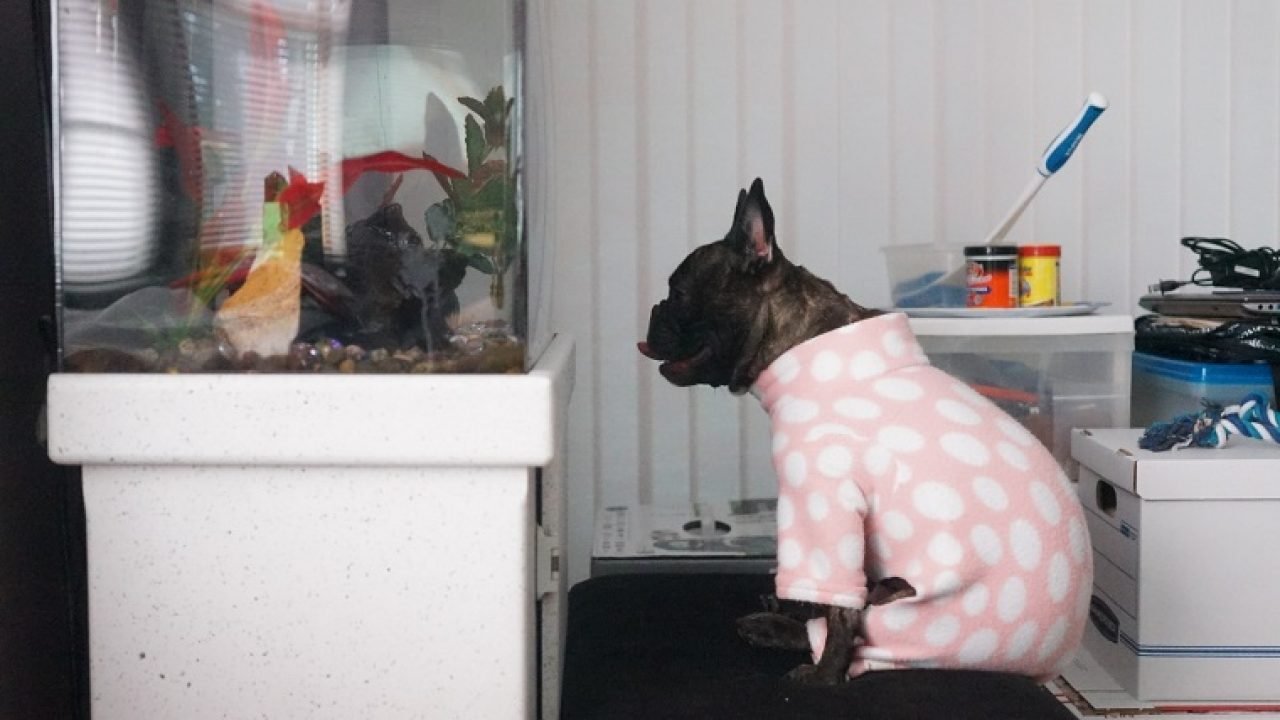Learn some simple tricks and cues you can use to keep your dog from harassing your fish tank.

by: David Thomas
In this article, you’ll learn four types of cues you can use to break your dog’s attention on your fish tank and keep them occupied with safer, more interesting things.
Keeping your dog away from your fish tank can be a real challenge. The sights, sounds, motion and especially smells of a fish tank are naturally deeply intriguing to an intelligent, curious animal like a dog, and their deep-seated evolutionary instincts will tell them that fish they smell are prey and therefore food, and therefore very much worth investigating further. This dynamic will be particularly powerful if you have a dog, like a terrier or setter, that was bred to have a high prey drive, or a Labrador or Portuguese water dog that was bred to have an interest in all things wet and splashy.
Luckily, in addition to the precautions you should take in setting up your fish tank, you can also train your dog to leave it alone. This training won’t necessarily be easy, as instituting training that will override your dog’s natural instincts to explore and check out potential food sources is always difficult. However, it will be well worth it when you avoid a catastrophic accident between your dog and your fish, and when you realize the peace of mind that comes from knowing your dog will behave when you tell them to, even if they’d rather keep sniffing the fish tank.
- Go to your place. This is probably the most useful skill you can teach your dog, after a strong recall command. You assign your dog a “place” in the house that’s theirs, where they can hang out and stay out of trouble. David Thomas from everythingfishkeeping.com recommends this is a crate or mat; ideally, it’s something you can move and still have your dog recognize and use as their place. To start training a go to your place command, you have to make the place appealing to them by filling it with toys and treats. In the beginning, reward your dog with treats and praise every time they hang out in their place, then every time they go to it, then eventually only when they go when you tell them to. It will take time, but once your dog has this skill down, you will have a perfect command to keep them out from underfoot in the kitchen or far away from your fish tank.
- Come. A reliable recall is crucial for your dog for a number of reasons, probably most notably as a safety measure if they start getting into anything dangerous, but it’s also incredibly useful for breaking their attention on something you don’t want them paying attention to – in this case, the fish tank. Having your dog come to you if they’ve been staring at the fish tank too long will break their focus on the tank, and also give them a reward for doing so, in the form of praise and pets for obeying their recall. It will also shift your dog’s focus onto you and what you’re doing, which will hopefully be more interesting to them than a fish tank that has never given them a belly rub or salmon treat.
- Spin. If you’ve brought your dog’s attention back to you and they’re still going back to the fish tank, you may have to up your attention redirecting game by introducing an element of play or training – something for your dog to think about other than the fish tank. Remember that however appealing the fish tank is to them, a well-trained dog will always prefer your attention and affection. You can ask your dog to sit, spin, dance, shake – anything that will let them succeed at a simple task and then bask in your praise and love. If you have time, you can turn this into a full-on training session or playtime. This will not only break your dog’s fixation and keep them away from the tank, but it will also tire them out, and a tired dog is much less likely to bother your fish tank.
- Hide and seek. This is another one where the actual command or trick you are asking your dog to perform is not as important as what you’re getting them to do, which is think about something other than the fish tank. When it comes down to it, all of these tricks work mostly by breaking your dog’s focus on the fish tank and redirecting their mental energy elsewhere. If your dog is extremely focused on the fish tank, though, and keeps going back to it, once you have their attention, you may have to assign them a fairly complex task – like playing hide and seek or retrieving a certain object from elsewhere in the house – to break that mental cycle and get them into a new frame of mind. Hide and seek or a retrieval task are good options because they get your dog to focus on objects in the house that aren’t the fish tank. Keep in mind that you want to set your dog up for success with this task, so give them a few simple cues first to make sure their attention is on you and they’re ready to listen and perform.
If you bring a fish tank into a house with a dog in it, or vice versa, the dog is going to be very curious about the tank. All it takes is a little vigilance and a lot of redirection from you before your dog will learn the fish tank has nothing to offer.


Leave a Reply